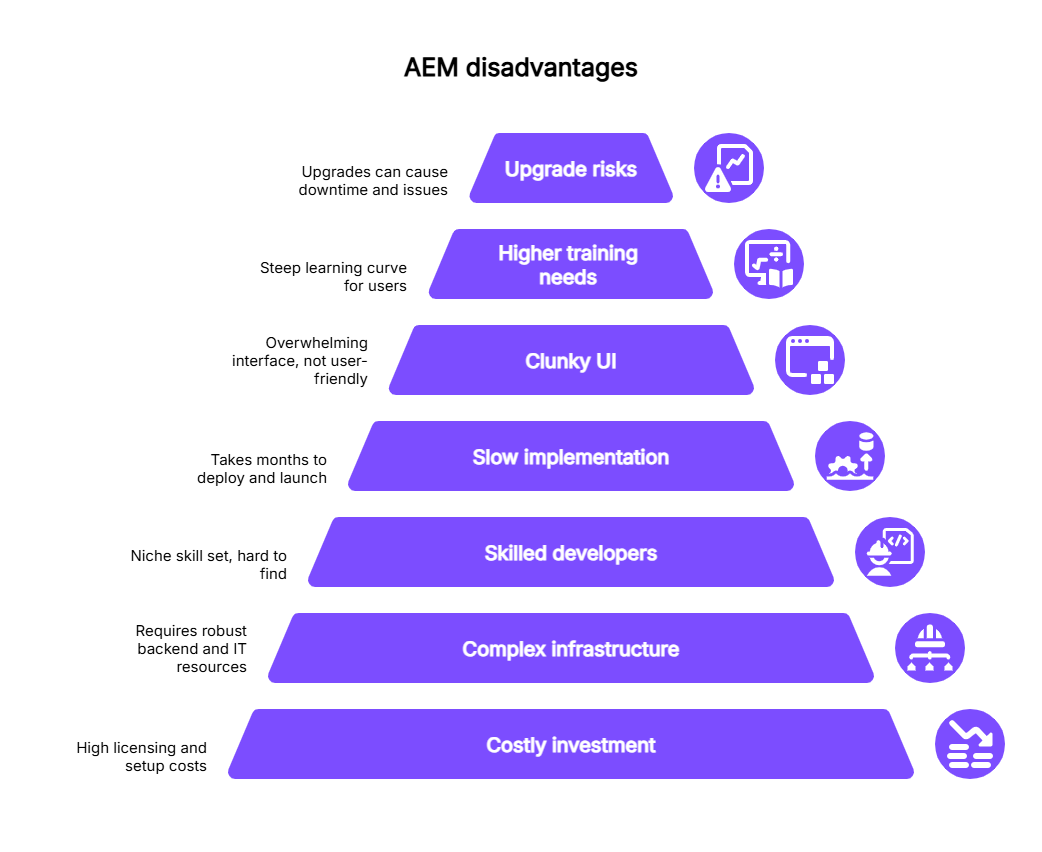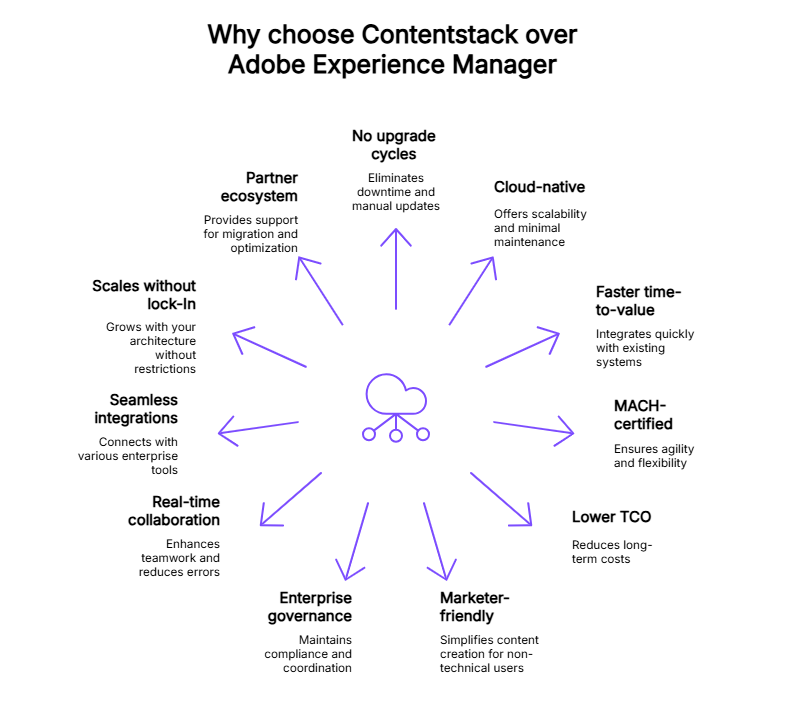10 Hidden Adobe Experience Manager disadvantages that are slowing you down

Struggling with high costs, clunky workflows and dev bottlenecks. Discover how the disadvantages of Adobe Experience Manager are holding your team back. There’s a better way to scale content faster, easier and upgrade: Contentstack.
Highlights
You’ll learn about the cons of AEM:
- High total cost of ownership: Licensing, hosting and hiring niche developers add up to the cost
- Slow implementation: Long rollout cycles delay time-to-value
- Steep learning curve: Developers and marketers struggle with complexity
- Upgrade friction: Even minor updates risk breaking workflows
- Poor collaboration tools: Limited visibility, no true staging and no audit trails
10 Adobe Experience Manager disadvantages
Beneath the gimmick of Adobe’s enterprise-grade CMS, teams find a maze of complexity, cost and bottlenecks that pull your business down. Here are some AEM disadvantages you should know:
1. You pay far more than just the license fee
AEM is the costliest CMS available on the market. The licensing fee is just the tip of the iceberg. To get your CMS up and running, you need investments in setup, infrastructure and AEM developers who are familiar with the platform. Before long, these costs can accumulate, making it challenging to utilize all the features.
2. You need help (a lot of it)
Is your team accustomed to plug-and-play features in a CMS? Then, AEM is not for you. The platform relies heavily on professional services for upgrades and configuration. What’s worse is that the dependency continues through integration, upgrades and configurations. This makes your website or business less agile and results in higher long-term costs.
Overcome traditional CMS issues with Contentstack: Are you tired of slow development times and rising costs due to legacy monolithic suites? Contentstack offers a modern, component-based solution designed for the needs of today's enterprises. Discover agility and improved ROI. Request a demo to learn more.
3. You need complex infrastructure to support it
AEM requires a robust backend to function effectively, particularly in on-premises or hybrid setups. You require the IT resources to deal with clusters, scale environments for higher uptime and handle DevOps. Adobe Experience Cloud fails to deliver optimum performance. Instead, many customers find the deployment pipeline extremely complex.
4. You struggle to find skilled AEM developers
Due to the complexity of AEM, it’s a niche skill set. It’s not easy to find developers who are familiar with AEM and its features. Such developers contribute exponentially to your overhead costs. However, if the hired developer quits midway, everyone scrambles to hire an experienced one to ensure your business isn’t stalled.
5. You cannot launch anything quickly
While you can deploy other headless CMS like Contentstack in less than a week, the AEM implementation takes anywhere from six to 12 months. From initial setup to full rollout, months can pass before your site or content is even live. For fast-moving and growing teams, that’s a major speed bump.
6. You have to work with a clunky and classic UI
AEM’s interface feels more clunky, particularly for those accustomed to cleaner, more user-friendly tools. Simple tasks require more clicks than needed. Moreover, the overall experience is overwhelming for first-time users. For instance, a simple image updation might take five steps, several tabs and some guesswork, compared to drag-and-drop editing on a modern CMS.
7. You frustrate your non-technical users
For non-technical users, AEM can easily become a nightmare to navigate. Many content editors and marketers face an uphill battle in making simple updates or fixing minor layout issues. For example, a content writer who wants to add a banner to a landing page must request the IT team to avoid altering certain functionalities. They cannot click and edit like they do in other CMS platforms, like Contentstack.
8. You won’t enjoy smooth upgrades
Upgrading AEM is rarely a smooth process. Minor changes may create an unforeseen problem, cripple workflows and compatibility or cause custom elements to break. If you have third-party systems and plugins or intensive customization, you need to test various steps for a smooth upgrade. Your development teams work to get your updates, and they are sweating it out to achieve the software release, but your content creation and editing teams sit idle, unable to move forward. The result? Slower release cycles, frustrated teams and unnecessary stress every time an upgrade is on the horizon.

9. You risk downtime every time you update
What happens when you see the dreaded “site’s down” message in the middle of a product launch or major campaign? It’s every team’s worst nightmare, and with AEM, it’s a real risk. Minor changes may result in severe issues, including broken components, plugin incompatibility or workflow failure. Due to the complexity of AEM and reliance on highly custom code, any update you wish to carry out needs to be planned, tested and cross-team coordinated. A single mistake can cause systems to fail, putting pressure on developers.
10. You witness slower innovation due to dependency on planned releases.
With AEM, you schedule every new feature or improvement in advance. Teams are forced to wait until scheduled release cycles to make changes. You cannot experiment with new features or functionalities. Failure to meet market demands and push improvements in real-time are among the reasons why companies seek AEM alternatives.
Why is Contentstack’s composable DXP a better alternative?
No painful upgrade cycles
Contentstack does not have any scheduled upgrades or risky migrations like Adobe Experience Manager. The design is upgrade-free. You get the latest features offering personalized experiences with no downtime, manual updates and version issues, and your team can concentrate on the building process, not updates.
Cloud-native from day one
Contentstack operates in the cloud, utilizing auto-scaling and built-in redundancy. You don’t have to manage infrastructure, handle on-premise headaches or hosting bills. The platform is designed for companies seeking global performance, reliability and minimal maintenance.
Faster time-to-value
It takes days rather than months to integrate Contentstack into your tech stack. You also save your time with free prebuilt connectors, low-code tools and flexible APIs. Teams deliver value faster, launching your content, campaigns or microsites without facing developer bottlenecks.
MACH-certified for future-ready architecture
Contentstack is a MACH-certified (Microservices-based, API-first, Cloud-native and Headless) product and as such, it's built for speed, agility and lasting flexibility. You’re not tied into a monolith, as you can opt for user management features and whatever you want, whenever you want.
Lower total cost of ownership (TCO)
Contentstack’s headless CMS offers minimal engineering overhead, maintenance operations and doesn’t force you to make upgrades. This is a long-term cost-saving solution. You invest less money in the infrastructure and more money in innovations, which reduces your total cost of ownership (TCO).
Marketer-friendly and intuitive
UI is developed with non-technical users in mind. Coders can create pages, reuse blocks, control translations and publish news without needing to engage developers. This results in shorter content cycles and reduced bottlenecks.
Built-in enterprise governance
Contentstack has built-in workflow support, permissions, audit trail and localization support. No matter how many brands, markets or teams you handle, you remain compliant and coordinated.
Real-time collaboration
Contentstack establishes connections between content and development teams through features such as live preview, modular and adjustable content blocks and environment-specific workflows. All of them collaborate and increase the rate at which deliveries can take place with fewer errors.
Seamless integrations with best-of-breed tools
Whether you’re using Google Analytics, Salesforce, Algolia, digital asset management (DAM) systems or any other enterprise tool, Contentstack integrates with it. You get the freedom to use the tools your team already loves, without being forced into a vendor ecosystem.
Visit Contentstack’s Marketplace to learn about the tools it can integrate with.
Scales as you grow without lock-in
Whether you're managing digital experiences for one website or multiple, Contentstack scales; there are no arbitrary limits or restrictive licenses. And since it’s API-first, it grows with your architecture.

A partner ecosystem that has your back
Whether you need to migrate or optimize, Contentstack's network of certified partners gets you the best from Contentstack. You get help with onboarding, custom integrations, strategic guidance and more.
Case study: How Dawn Foods accelerated its digital transformation with Contentstack
Dawn Foods moved from Adobe’s CMS to Contentstack to support its digital transformation using the MACH technology. The platform allowed content managers to update content 80% faster without a developer. Over a six-month period, it released six major versions and more than 40 quick fixes in response to user feedback. The flexibility, usability and scalability of Contentstack ensured high adoption and better online ordering experiences.
After using Contentstack, Gireesh Sahukar, Vice President of Digital at Dawn Foods, said:
“I have worked with content in other systems such as Adobe, Kentico, Sitecore and more. It was pretty painful. To think that my team is managing all the content without needing technical skills whatsoever is astonishing.”
Read the case study here.
IDC MarketScape recognizes Contentstack's excellence, naming us a Leader in Headless CMS by IDC MarketScape, Contentstack demonstrates a future-proof CMS strategy, R&D pace in innovation, and exceptional customer delivery. Discover how we can elevate your digital experiences. Request a demo to learn more.
Why Contentstack wins the Adobe Experience Manager comparison
Here’s why Contentstack is a better alternative to AEM:
| Feature | Contentstack | Adobe Experience Manager (AEM) |
| Upgrades and maintenance | Always up to date with no manual upgrades; cloud-native and upgrade-free | Complex, costly upgrade cycles with risk of downtime and regression |
| Time-to-market | Fast implementation with plug-and-play integrations; launch in weeks | Long setup cycles due to heavy custom development and testing |
| Architecture | MACH-certified: Modular, API-first, cloud-native and headless | Monolithic at its core; requires custom development for flexibility |
| Ease of use for marketers | Intuitive UI, live preview, visual workflows, no dev help needed | Steep learning curve; often requires dev support for content changes |
| Collaboration | Real-time editing, approval workflows and role-based access built in | Siloed tools and workflows, less fluid collaboration between teams |
| Content governance | Built-in localization, versioning, roles and audit trails | Available but often needs custom setup and development |
| Developer experience | Clean APIs, Git-like workflows, CLI tools and composable architecture | Rigid content models, upgrades and deployments require careful coordination |
| Total Cost of Ownership (TCO) | Reduced long-term expense by fewer infrastructure, maintenance and dev-dependency | High TCO due to infrastructure, licensing, custom dev and specialized support |
| Extensibility and integrations | Uses best-of-breed applications such as Google Analytics, Salesforce and others | Tightly coupled to Adobe’s ecosystem; harder to integrate non-Adobe tools |
| Scalability | Scales easily across markets, brands and teams without added complexity | Scales with effort; complex licensing and infrastructure planning required |
FAQs
What are the disadvantages of AEM?
AEM is expensive, complex to maintain and requires specialized development. It lacks built-in localization workflows and native content preview.
Is Adobe Experience Manager worth it?
AEM is worth it only for large enterprises invested in Adobe’s ecosystem. For agile teams, the high cost and slow delivery cycles are a dealbreaker.
What are the performance issues of AEM?
AEM has poor page load speed, long publish phases and scaling issues for customized environments.
What are the advantages of Adobe Experience Platform?
AEP provides real-time profiles, unified data and seamless Adobe integration to personalize and analyze visitor behavior.
Learn more
If upgrade cycles keep slowing things down, if your integrations take weeks instead of days, if your costs keep scaling but the returns don’t, then it might be time to ask the hard question: is AEM still the right fit?
When marketers feel stuck and developers are constantly putting out fires instead of building new things, it’s a sign your CMS is working against you, not for you. This is where Contentstack comes to the rescue. The platform is quick, adaptable and designed to facilitate teams working faster. No upgrade issues, no awkward processes, just a system that provides your team with the velocity and flexibility they need to do it faster and do it better.
Are you tired of your current CMS? Consider switching to a modern CMS like Contentstack, where new teams can operate efficiently. To know more about how Contentstack helps, talk to us.
About Contentstack
The Contentstack team comprises highly skilled professionals specializing in product marketing, customer acquisition and retention, and digital marketing strategy. With extensive experience holding senior positions at renowned technology companies across Fortune 500, mid-size, and start-up sectors, our team offers impactful solutions based on diverse backgrounds and extensive industry knowledge.
Contentstack is on a mission to deliver the world’s best digital experiences through a fusion of cutting-edge content management, customer data, personalization, and AI technology. Iconic brands, such as AirFrance KLM, ASICS, Burberry, Mattel, Mitsubishi, and Walmart, depend on the platform to rise above the noise in today's crowded digital markets and gain their competitive edge.
In January 2025, Contentstack proudly secured its first-ever position as a Visionary in the 2025 Gartner® Magic Quadrant™ for Digital Experience Platforms (DXP). Further solidifying its prominent standing, Contentstack was recognized as a Leader in the Forrester Research, Inc. March 2025 report, “The Forrester Wave™: Content Management Systems (CMS), Q1 2025.” Contentstack was the only pure headless provider named as a Leader in the report, which evaluated 13 top CMS providers on 19 criteria for current offering and strategy.
Follow Contentstack on LinkedIn.





